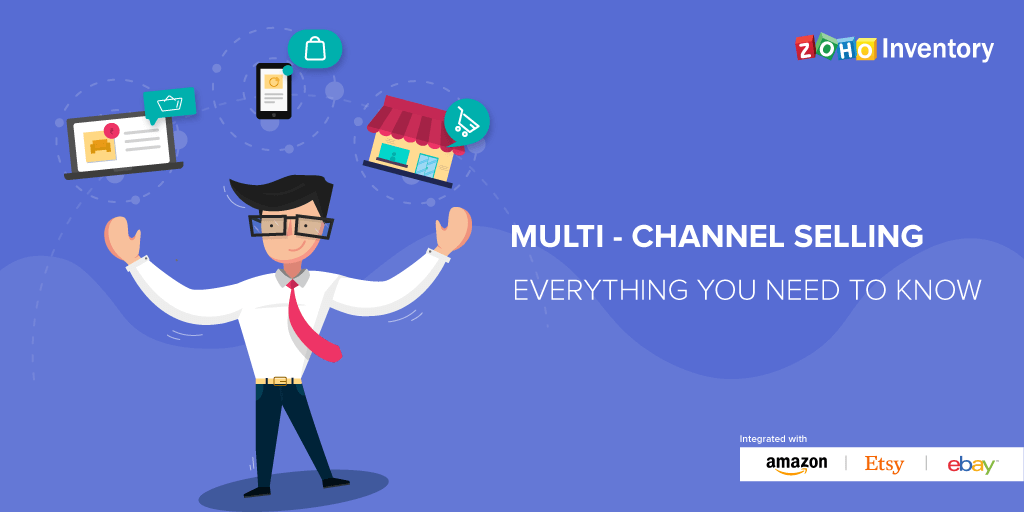If you’re an online seller on Amazon, eBay or Etsy, then there’s a high chance that you’ll have heard the words “Multi-channel selling.” While many of you may think that it refers to selling on multiple online marketplaces, there’s more to it. Multi-channel selling means expanding your selling channels, and such channels can be both online and off. To get the maximum exposure for your products and gain access to customers across the globe, you need the multi-channel model of business.
Increasing your selling channels by just listing your products on a variety of online marketplaces may not help you scale your business. Depending on the products you sell, you’ll need to know how to leverage all of the online marketplaces and also keep track of your offline business. Keep reading to learn more about boosting sales and growing your multi-channel business.
1. Choosing the right sales channel
In today’s business world, expansions don’t mean another retail store. From using different online marketplaces to having your own website and warehouse locations, there are many ways to increase your selling channels. Here are significant factors to consider when adding more sales channels for your business.
a.Online marketplaces
There are a number of online marketplaces you can list your products on. Apart from the global ones like Amazon, Etsy, and eBay, there are also vertical and horizontal marketplaces that sell specialized categories of products like jewelry, clothing, and so on. Create a list of all the marketplaces that are relevant to your products and list their pros and cons. This approach can be very helpful for prioritizing your focus.
Before creating a seller account and listing your products, you’ll need to understand the fee structure and the terms and conditions of the different online marketplaces. This will also help you analyze the return on investment. You can also take a look at dedicated user groups and forums like Amazon’s Seller Central to get more information and insight.
Once you get a clear idea about how each marketplace works and how well you can leverage them, create your seller accounts for them. Creating a seller account is much easier and simpler if you already have a product portfolio.
b.Online store
A major disadvantage to selling in marketplaces is that customers have access to alternatives to your products and there’s no guarantee of repeat sales. Having your own website/web store helps you build your brand image while also increasing your customer base. The best part is that it’s very simple and easy to start your online store. There are many solutions out there, like Shopify, Magento, and Bigcommerce, for launching online stores.
c.Retail/physical stores
There are still certain categories of products that shoppers prefer going to a retail store for. Moreover, many shoppers enjoy the entire experience of shopping in a physical store. Based on the return on investment, customer preference, market trends, and budget, it might be a good idea to expand your retail stores as well.
2. Selling on Multiple sales channel
Be it an online marketplace or a brand new online store, there are a few things you need to do to increase the credibility of your listing or your website.
Here’s a quick checklist of things you need to do to get your first sale:
- Promote your products with beautiful high–resolution images.
- Send product samples to influencers in your industry and get their feedback.
- Ask people you know to use the product and write product reviews.
- Blog about your product and post them on relevant forums.
- Use social media channels like Facebook, Twitter to promote your product.
- Give launch offers and discounts.
- Use sponsored advertisements on online marketplaces to promote your product.
- Make sure you have the right keywords for your products.
- Keep tabs on your competitors and update your product portfolio accordingly.
Once you shortlist your channels, start selling your products. After a few weeks or months, you’ll be able to analyze which marketplaces are performing best so you can reallocate your time and effort to get the best returns.
3. Managing your multi-channel business
As your business grows, managing it becomes an even bigger challenge. You’ll need to update your product listings, maintain inventory levels, and collect payments. And if you sell out of a brick-and-mortar storefront or if you make direct sales on a daily basis, you’ll need to keep track of your offline sales as well.
With so much up in the air, it‘ll be impossible to focus on boosting your sales if you don’t have an integrated system. You’ll want centralized control over all your selling channels, so you have a place to create, manage, and monitor all your business activities.
Luckily, there is software out there that can help manage your multi-channel business more efficiently. Here’s what an ideal software solution will do for you:
- Integrate with online marketplaces and other e-commerce platforms.
- Automatically update your inventory quantities across all of your selling channels.
- Automate your entire sales process, from creating sales orders to shipping products, to tracking delivery status.
- Offer a comprehensive dashboard and extensive reports, giving you the ability to measure channel performance minute by minute.
There isn’t one right way to run an online business. Test new channels, experiment with different ways of selling and expand your reach. Just remember: the key to running a successful online business is to think about the things you look for in an online shopping experience and incorporate those successful techniques into your own selling practice.
If you found this information helpful, or if you have your own tips and tricks you’d like to add, let us know in the comments!

